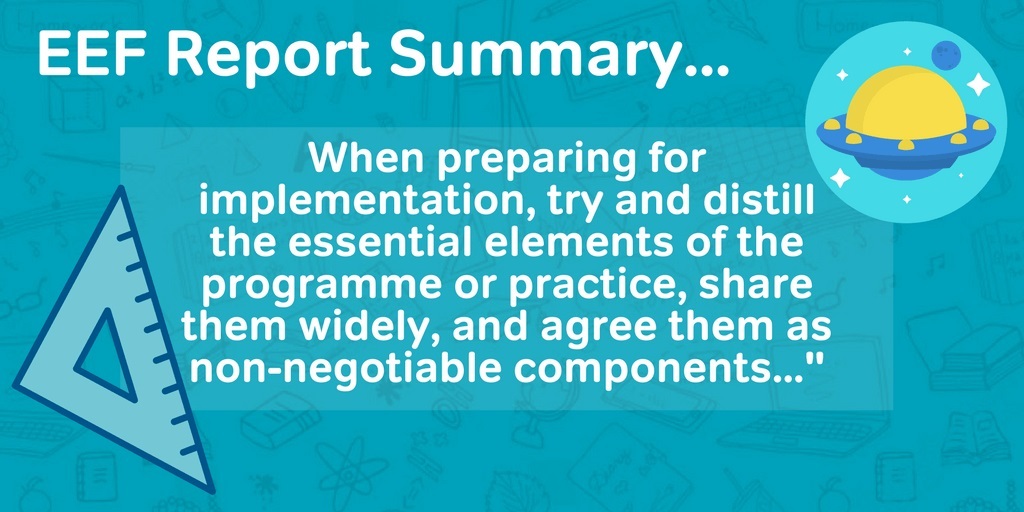EEF Putting Evidence To Work Report [SLT Summary]
All you need to know about the EEF Putting Evidence to Work Report and what effective change looks like for primary schools. Essential reading for school leaders and Maths teachers, including the do’s and don’ts of implementation from a Maths Leader with practical experience.
Winds of change blew in the world of primary Maths when the 2014 National Curriculum was introduced. We now had to teach some things sooner, other things later, some things not at all and there were additions too (hello, Roman numerals!). The ‘new’ holy trinity of Maths teaching and learning were introduced: fluency, problem solving and reasoning.
Then the SATs gradually changed. The calculation paper had already been done away with; next to go was the mental Maths test, replaced by the arithmetic test. And the reasoning tests appeared to begin to assess how pupils were doing on the 2014 curriculum ahead of schedule. The two new reasoning papers were perceived by many to be more difficult than before.
And so, up and down the land, Maths leaders and teachers have been making changes to the way the subject is taught in their schools. Even 4 years on, new resources and teaching strategies are being implemented in the name of improving Maths teaching and learning.
Change is one of the things that teachers resent the most. We just want to be allowed to get on with the job, and for any new initiatives to have time to embed. Making changes to how things are done in schools is not an easy task.
The Senior Leader’s Guide to Pupil Premium
Informative and concise guides on the interventions that will have the biggest impact for the children in your care.
Download Free Now!Latest EEF Report: Putting Evidence To Work
This is where the EEF’s latest guidance report comes to our rescue. Even if you have been well-trained in models for effecting change, this handy document offers you easy-to-digest advice on what research shows is the best way to go about transforming teaching and learning in your school.
The guidance report acknowledges how our desire to tweak our practice with the children in mind leads to piece-meal change-making:
“Implementation is a domain of school practice that rarely receives sufficient attention. In our […] haste to do better for pupils, new ideas are often introduced with too little consideration for […] what steps are needed to maximise the chances of success.”
Indeed, in his introduction Sir Kevan Collins points out that:
“Implementing effective practices to the best of our abilities is […] absolutely critical to yielding the promise that our increased access to evidence affords [because] it doesn’t matter how great an educational idea […] is on paper; what really matters is how it manifests itself in the day-to-day lived reality of schools.”
I’m sure we’d all agree with this. If there’s one thing we hate more than change, its poorly-implemented change which seemingly has no impact whatsoever.
To combat this, the report proposes a simple model of evidence-informed school improvement (which is expanded upon throughout the report):
- Decide what you want to achieve.
- Identify possible solutions and strategies.
- Give the idea the best chance of success.
- Did it work?
- Secure and spread change
This is supplemented by an excellent graphic which follows the process of Explore, Prepare, Deliver, Sustain:

Implementing Change Must Mean Implementing Impact
Recently, I admit, I hastily implemented a change in the way we teach Maths at my school.
After an enlightening morning spent with a highly-respected Maths consultant I realised that whilst our practice wasn’t lacking, it could be made more consistent school-wide.
I took his advice and prepared to deliver a version of the AET Mathematics Mastery Flow Model in order to provide a definite and challenging learning sequence involving the use of representatives, fluency practice, problem solving and reasoning.
The new school-wide Maths Learning Sequence Structure I introduced is a quick at-a-glance model of the progression stages for Maths across all year groups in our school. It includes links to several free resources and guidance and is compatible with White Rose Maths resources and other schemes.
In my excitement I prepared documents. I made a display in the PPA room explaining the new process. I visited each PPA session to spend time going through how I thought Maths teaching could be tweaked.
It appeared to be well-received and teachers have had a very good go at implementing it. But having read the EEF guidance report, I know that perhaps I should have gone about things differently. From here on in, there are definite implications for how I continue to ensure the implementation goes smoothly.
Key Highlights From The EEF ‘Putting Evidence To Work Report’
With those two things in mind, here are a few choice quotations from the guidance report, that you should bear in mind:

Thankfully, this is what I did initially. The structure I presented contained the basic steps that I wanted teachers to take in their Maths lessons and I ensured that these had been communicated to all teachers as an expectation.
However, the fact that I shared with all teachers immediately meant that there was not a trial period

Again, the approach, although new and perhaps novel, was implemented for a real purpose and was not just for the sake of it.
However, my approach to implementation was probably not that disciplined: I didn’t assess the readiness of the school before delivery and the delivery itself was concerned only with a one-off introduction to the changes I wanted to see.
Although I did provide lots of resources for teachers to use when delivering the new approach I hadn’t considered and planned how I would provide ongoing support.
In essence, I hoped that I could prepare and deliver in a very short space of time and then expected for successful change to be sustained. This is not realistic, and is not supported by the guidance report’s recommendations.
I treated implementation as an event rather than a process not taking into account that “investing time and effort to carefully reflect on, plan, and prepare for implementation will reap rewards later”.

This is a perennial issue, particularly in schools which are needing to improve rapidly –everything becomes a priority.
Thankfully, in my case, I had already done plenty of training on the use of representatives, fluency, problem solving and reasoning so the change I was proposing wasn’t so much of an ‘add on’ – it was more of a structure to slot all the current good practice into to ensure all the previous training was being put into practice.

I expected the following to happen: I train the teachers, the teachers do it. No problem. How naïve! Reading through the guidance report was a timely reminder that this half term I need to follow up on any possible surprises, setbacks and barriers to the use of the structure I introduced.
I thought my implemented changes were simple enough to embed themselves without a problem, but I can’t be sure of this until I’ve monitored and evaluated how successful the implementation has been.

This was a big wake up call for me. But shouldn’t they just be doing what I’ve asked them to do and it’ll all be OK? Isn’t it a fail-safe idea?
Maybe it is to me, but what works in my mind might not work for all. Again, I am reminded that support needs to be ongoing and that crucially, I, along with my fellow leaders, need to ensure that the environment we are working in is one where teachers feel able to make mistakes whilst trying new things.
Whilst I hope that we do have such a culture, it is probably still developing and therefore I need to be mindful of that as I assess how well the changes are being embedded.
What I’ve Learned From The EEF ‘Putting Evidence To Work’ Report
But what will I do differently next time?
Having reflected on implementing a change without following the procedure laid out in the EEF’s guidance report I am resolved to backfill where I can in order to ensure a successful implementation.
But next time I implement a change I will have the guidance to hand and will create a plan that takes into account the EEF’s recommendations that when implementing change we:
- Treat implementation as a process, not an event; plan and execute it in stages.
- Create a leadership environment and school climate that is conducive to good implementation.
- Define the problem we want to solve and identify appropriate programmes or practices to implement.
- Create a clear implementation plan, judge the readiness of the school to deliver that plan, then prepare staff and resources.
- Support staff, monitor progress, solve problems, and adapt strategies as the approach is used for the first time.
- Plan for sustaining and scaling an intervention from the outset and continuously acknowledge and nurture its use.
If you found this interesting, check out one of our most popular blogs on leadership issues in primary schools: ‘Keeping It Simple, The Secret To School Leadership’.
READ MORE: A Teacher’s Guide To Spaced Repetition
DO YOU HAVE STUDENTS WHO NEED MORE SUPPORT IN MATHS?
Every week Third Space Learning’s specialist school tutors support thousands of students across hundreds of schools with weekly online 1 to 1 maths lessons designed to plug gaps and boost progress.
Since 2013 these personalised one to 1 lessons have helped over 150,000 primary and secondary students become more confident, able mathematicians.
Learn how tutors build rapport or request a personalised quote for your school to speak to us about your school’s needs and how we can help.

![EEF Putting Evidence To Work Report [SLT Summary]](https://thirdspacelearning.com/wp-content/uploads/2018/07/Combined-pupil-premium-guides-featured-image.png)



